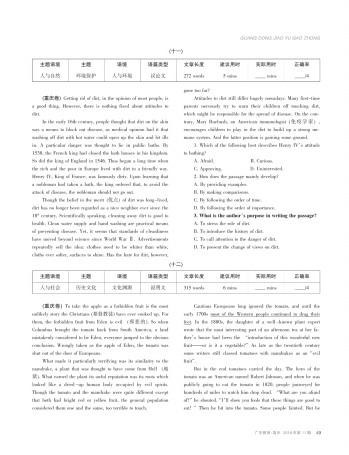In the early 16th century, people thought that dirt on the skin was a means to block out disease, as medical opinion had it that washing off dirt with hot water could open up the skin and let ills in. A particular danger was thought to lie in public baths. By 1538, the French king had closed the bath houses in his kingdom. So did the king of England in 1546. Thus began a long time when the rich and the poor in Europe lived with dirt in a friendly way. Henry IV, King of France, was famously dirty. Upon learning that a nobleman had taken a bath, the king ordered that, to avoid the attack of disease, the nobleman should not go out.
Though the belief in the merit(优点)of dirt was long-lived, dirt has no longer been regarded as a nice neighbor ever since the 18th century. Scientifically speaking, cleaning away dirt is good to health. Clean water supply and hand washing are practical means of preventing disease. Yet, it seems that standards of cleanliness have moved beyond science since World War Ⅱ. Advertisements repeatedly sell the idea: clothes need to be whiter than white, cloths ever softer, surfaces to shine. Has the hate for dirt, however, gone too far?
Attitudes to dirt still differ hugely nowadays. Many first-time parents nervously try to warn their children off touching dirt, which might be responsible for the spread of disease. On the contrary, Mary Ruebush, an American immunologist(免疫学家), encourages children to play in the dirt to build up a strong immune system. And the latter position is gaining some ground.
1. Which of the following best describes Henry IV’s attitude to bathing?
A. Afraid. B. Curious.
C. Approving. D. Uninterested.
2. How does the passage mainly develop?
A. By providing examples.
B. By making comparisons.
C. By following the order of time.
D. By following the order of importance.
3. What is the author’s purpose in writing the passage?
A. To stress the role of dirt.
B. To introduce the history of dirt.
C. To call attention to the danger of dirt.
D. To present the change of views on dirt.
(重庆卷)To take the apple as a forbidden fruit is the most unlikely story the Christians (基督教徒) have ever cooked up. For them, the forbidden fruit from Eden is evil (邪恶的). So when Columbus brought the tomato back from South America, a land mistakenly considered to be Eden, everyone jumped to the obvious conclusion. Wrongly taken as the apple of Eden, the tomato was shut out of the door of Europeans.
What made it particularly terrifying was its similarity to the mandrake, a plant that was thought to have come from Hell (地狱). What earned the plant its awful reputation was its roots which looked like a dried-up human body occupied by evil spirits. Though the tomato and the mandrake were quite different except that both had bright red or yellow fruit, the general population considered them one and the same, too terrible to touch.
Cautious Europeans long ignored the tomato, and until the early 1700s most of the Western people continued to drag their feet. In the 1880s, the daughter of a well-known plant expert wrote that the most interesting part of an afternoon tea at her father’s house had been the “introduction of this wonderful new fruit——or is it a vegetable?” As late as the twentieth century some writers still classed tomatoes with mandrakes as an “evil fruit”.
But in the end tomatoes carried the day. The hero of the tomato was an American named Robert Johnson, and when he was publicly going to eat the tomato in 1820, people journeyed for hundreds of miles to watch him drop dead. “What are you afraid of?” he shouted. “I’ll show you fools that these things are good to eat!” Then he bit into the tomato. Some people fainted. But he




